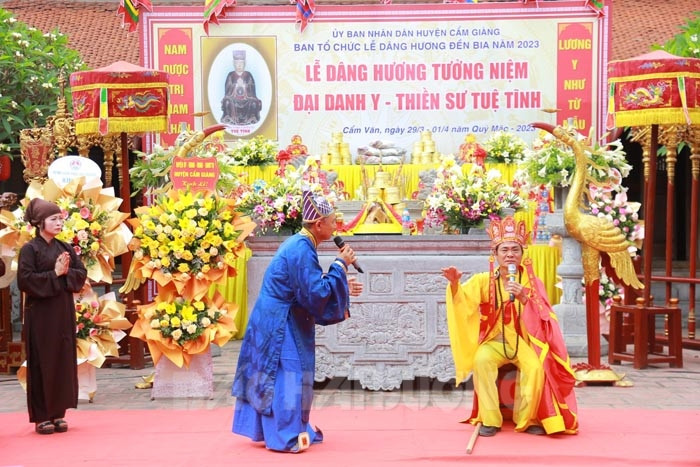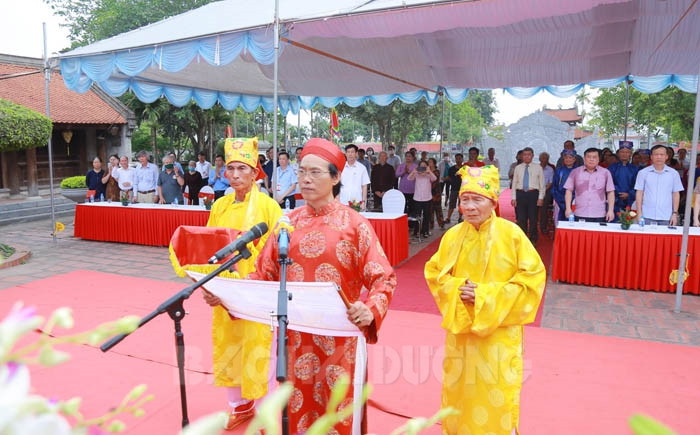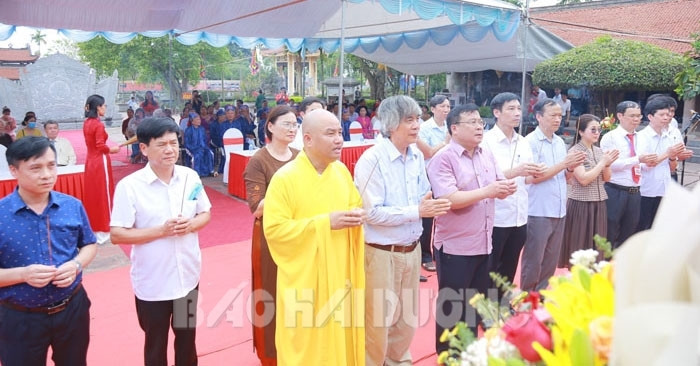The incense offering ceremony in memory of the Great Physician, Zen Master Tue Tinh shows respect for history, the ethics of drinking water and remembering its source, honoring medical ethics, and promoting traditional Vietnamese medicine.

The Cheo performance recreates the scene of the famous physician, Zen master Tue Tinh anxiously longing to return to his homeland.
On the morning of May 19 (April 1st of the lunar calendar), the People's Committee of Cam Giang district, the People's Committee of Cam Van and Cam Vu communes, together with a large number of people and tourists from all over the country, solemnly held an incense offering ceremony to commemorate the Great Physician and Zen Master Tue Tinh.
The Bia Temple is located in Van Thai village (Cam Van commune), where the sacred will of the great physician, Zen master Tue Tinh is kept. His real name is Nguyen Ba Tinh, born in 1330 in Nghia Phu village, Van Thai commune, Thuong Hong district, now Nghia Phu village (Cam Vu commune). At the age of 6, he became an orphan and was taken in and raised by the abbot of Nghiem Quang pagoda (Giam pagoda). Throughout his childhood, he relied on the Zen monastery.
At the age of 22 (1351), he passed the Imperial examination but refused to become an official. Having to witness major epidemics that took the lives of the poor, with the desire to turn misfortune into fortune, bring the dead back to life, and save the people, he studied plants, flowers, and medicinal herbs and actively planted medicinal herbs, continued to collect valuable folk remedies, established clinics right at pagodas to treat illnesses with simple but effective remedies and methods to help the poor and suppress major epidemics.

Speech praising the merits of the great physician, Zen master Tue Tinh
Current sources indicate that he participated in the construction of 24 pagodas and turned them into medical facilities, saving many people from illness. With Tue Tinh's dedication, the movement of growing medicinal herbs has been increasingly spread, with many families growing their own herbs and treating their own illnesses.
At the age of 55, his medical career was flourishing when King Tran appointed him to join the diplomatic mission to the Ming Dynasty (China). Due to his talent in curing the illness of Song Wangfei (King Ming's wife), King Ming appointed him as a royal physician and Zen master and kept him to work at the Imperial Medical Institute. Some time later, he died in Jiangnan.
Tue Tinh's life and career have left for posterity valuable legacies in many fields, which are important contributions to the treasure of traditional medicine and pharmacy knowledge. In more than 30 years of scientific activities, he has collected, researched, systematized, and summarized treatment methods, including 10 faculties, 2 subjects, with 3,873 prescriptions, 580 medicinal herbs to treat 184 diseases. Tue Tinh has made great contributions in theory and practice to traditional medicine and pharmacy, his career is constantly inherited and promoted. The great physician Hai Thuong Lan Ong Le Huu Trac is a worthy successor to his career in the 18th century.

Delegates and people offer incense to commemorate the Great Physician, Zen Master Tue Tinh.
When he died, on his tomb in Jiangnan (China), he had a stele engraved with the words "If anyone from the South comes here in the future, please remember to bring my remains back with you." In 1690, Dr. Nguyen Danh Nho (1638-1699) - a native of Nghia Phu village, during his mission to the North, saw the tomb of the Great Physician, Zen Master Tue Tinh. Moved by the Great Physician's desire to return to his homeland, Dr. Nguyen Danh Nho had a stele engraved with Tue Tinh's last wish. The stele is currently being solemnly worshiped in the back palace of the Bia Temple.
Although Tue Tinh has been away for nearly 700 years and has not returned to his homeland, in his hometown of Cam Giang, within a small space of 3 square kilometers, there are 3 places to worship him: Xua Temple in Nghia Phu Village (Cam Vu Commune), Giam Pagoda (Dinh Son Commune) and Bia Temple (Can Van Commune). On December 25, 2017, the 3 relics were recognized by the Prime Minister as special national relics.
TIEN HUY